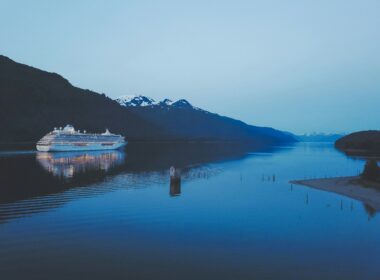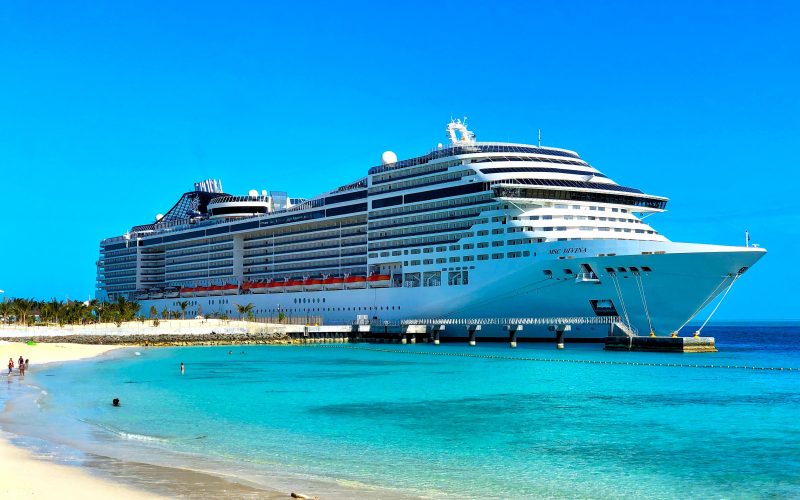Go big or go home? Well, not always. While large ships offer myriad dining and entertainment options, the sheer size of the vessel and the number of people onboard can be overwhelming for some travelers.
With many cruise options, deciding which size ship is right for you can be stressful. To help ease the burden, here are some key differences between larger and smaller ships and what to expect in each experience.
Big Action? Big Ships.

Generally, a “large” cruise ship is considered a vessel with 5,000 passengers or more. Large vessels tend to travel on well-known routes, mainly through the Caribbean.
On bigger ships, attractions are the name of the game. Some of the largest vessels offer entertainment, rivaling the most popular theme parks. For example, Carnival Cruise Line’s Mardi Gras boasts an onboard roller coaster, Royal Caribbean’s fleet offers rock climbing walls, and the newest Norwegian Cruise Line ships even have go-kart racetracks! Along with ample space for lounging by the pool and having fun on waterslides, some newer onboard entertainment includes game shows, sports tournaments, laser tag, and virtual reality experiences.
Looking for live entertainment? Large ships will have you covered! The onboard theaters will typically have several productions to choose from, sometimes offering full-scale Broadway shows such as “Cats” and “Jersey Boys.” MSC Cruises will occasionally have the famous circus troupe, Cirque du Soleil perform in their theaters. Live music is also abundant on bigger ships, providing live performances across the musical spectrum. Comedians are also known to perform special stand-up routines on large ships.
As for nightlife, look no further! Big ships have ample options for guests looking to dance the night away. Bars, lounges, discos, and nightclubs will be plentiful to ensure that every guest has the chance to party like rock stars.
Hungry? Large ships are like floating cities, stocked with a variety of options that rival the ones on land! Cavernous dining halls serving casual three-course meals, pizza parlors, buffets, taco stands, dessert shops, and hamburger grills abound. Specialty restaurants serving cuisine including Japanese, Italian, French, and steakhouse fare are also plentiful. Needless to say, a hungry guest will be hard to find on ships!
What about the living situation?
Large ships offer a wide range of accommodation options, catering to various budgets and preferences. Housing options span from affordable inside cabins to luxurious balcony cabins and opulent suites, some even featuring private outdoor hot tubs. The most expansive ships feature exclusive suite complexes that resemble miniature ships within the main vessel and come equipped with their own private restaurant and pool facilities, providing a truly exclusive experience.
The noise level can be quite high, particularly when there are many children on board, and there will undoubtedly be moments when you feel like part of a crowd (especially as ships return to their pre-pandemic occupancy levels). However, this doesn’t mean that adults cannot find peaceful areas to escape, such as the adults-only pool and sundeck areas, the expansive spa and fitness facilities, or a specialty restaurant for a romantic dinner. While adults enjoy themselves, the children will be well-engaged and cared for in a camp-like kids’ program. There are often separate activities designed for teenagers and ‘tweens who are hard to please.
While it’s possible to spend your time on big ships simply gazing at the ocean, isolating yourself in your cabin, and enjoying room service, that’s not truly the essence of the experience. The real enjoyment comes from embracing the excitement of dressing up and venturing out for a night on the town.
Small Ships, slower pace

Typically, a “small” ship is a vessel holding 400 passengers or fewer. The ships focus more on the destinations, offering itineraries covering more off-the-beaten-path ports with nature and cultural excursions. Due to their shallow drafts, some smaller ships can dock in yacht harbors.
Due to their smaller size, the onboard amenities provided are far fewer than their larger counterparts. Expect a few dining options, a lounge and/or bar area, a small fitness center, and a spa. A pool might be on the top deck, but hot tubs are more likely to be there.
Although a few of the more sizable small ships feature onboard musicians, such as a piano player and a song-and-dance ensemble, it’s important to keep in mind that if you’re sailing on a ship with only a handful of fellow passengers, the entertainment options may be limited. You might come across a crew member strumming a guitar for a delightful singalong session, or the cruise company may arrange for local performers to come aboard at a port of call, inspiring everyone to dance and revel on the deck.
However, a unique advantage of many small ships is their inclusion of an aft-end marina, which usually houses water toys, including kayaks, paddleboards, and even sailboats for guests to take out on the water. Embarking on a plunge straight from the ship into the sea is symbolic, especially when the water is icy cold. In such instances, your brave endeavor will likely receive applause and admiration from your fellow passengers.
Some smaller ships are purpose-built expedition ships that offer the opportunity to see nature up close, such as glaciers, waterfalls, whales, and more. A team of naturalists, scientists, glaciologists, historians, and other experts will be onboard, providing enlightening lectures and leading explorations using inflatable Zodiac boats and kayaks. The latest expedition ships may even come equipped with private helicopters and submarines for remote excursions.
Dining options vary depending on the cruise line. For instance, Windstar Cruises‘ elegant small sailing and motor yachts offer a selection of dining rooms and specialty restaurants, some featuring dishes crafted by renowned celebrity chefs. On smaller Lindblad Expeditions and UnCruise Adventures ships, dining is a communal experience shared by all passengers in a single seating. Meanwhile, the luxury line SeaDream Yacht Club allows you to arrange your dinner party on the deck, creating a personalized and memorable dining experience.
A More Simple Life at Sea
Given the relatively small number of passengers on board, ranging from a few hundred to just a few dozen, you will have the opportunity to develop meaningful connections with your fellow travelers. It’s challenging to remain anonymous in such an intimate setting, but on the flip side, it’s effortless to forge new friendships.
Among your shipmates, you’ll encounter a diverse mix of seasoned cruisers and newcomers enticed by the ship’s destinations, which range from secluded tropical islands to polar regions or highly sought-after bucket list locations. It’s worth noting that some small ships rarely follow the same route twice, ensuring a unique and distinctive voyage each time.
On the smallest and oldest vessels, the cabins offer a bare-bones layout, sometimes featuring fixed twin beds with uncommon balconies. In contrast, if you opt for a voyage on Silversea‘s Silver Origin, accommodating only 100 passengers in the Galapagos, or aboard Crystal Cruises‘ recently introduced 200-passenger Crystal Endeavor, you’ll reside in an exquisite suite adorned with elegant furnishings and enjoy the convenience of personalized butler service.
Which will you choose? A large or a small ship? Let us know in the comments!
By Ethan Leckie










